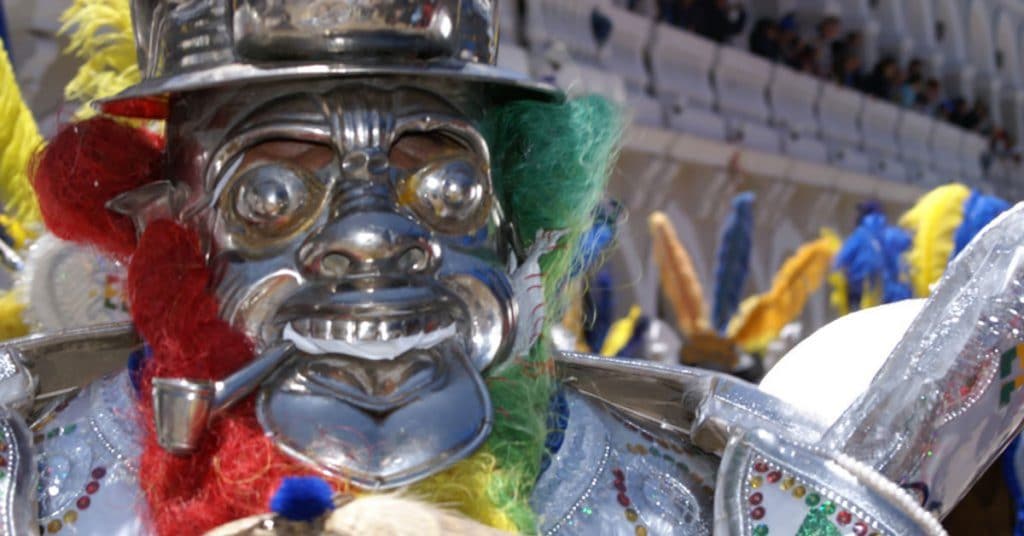The 2018 Queens Bolivian Day Parade marches up 37th Avenue, from 69th to 86th St, in Jackson Heights, Queens on Sunday, October 21, 2018 from 12 noon to 1 pm.
Bolivian Day Parade
You may think you are watching a flashy parade, but you are actually seeing an expression of our ancient heritage mixed with Spanish influences.
We are proud of our Indigenous roots and happy to be free from Spanish enslavement (1524 – 1809), so we dance.
We dance the Caporales, La Diablada, Morenada, Tinku and other dances in ways that combine our ancient Andean heritage with the Spanish influence of Carnival.
To release the pain of enslavement and gently teach our children what happened, we make fun of those who hurt us.
Many of these traditions probably originated in the stables where we lived as slaves. Imagine that you survived the terrible journey from Africa. After witnessing the most outrageous behavior by your masters, you come home to the stables at night. You and your fellow slaves speak different African languages so to tell the story you mimic what you saw. Everyone has a laugh through the pain and you survive another day. This is our heritage.
Caporales
Caporales dancing was created in 1969 by the Estrada Pacheco brothers in the capital, La Paz.
They were inspired by Afro-Bolivian dances of the Yungas region, the temperate forests on the eastern slopes of the Andes. These are lovely warm mountain forests that you should see once in your life.
Caporales dancers play the role of the slave driver. He was usually a mixed race person. In a way, he himself was tortured because half of him was forced to brutalize the other half of him. In life, this character was never happy, although the dancers are happy.
We wear carnivalesque costumes with boots and jingle bell spurs we call “cascabeles.” We carry a hat in our left hand and a whip in our right.
We jump up and down in an animated way, imitating the meanness of the slave driver forcing the slaves to work.
A Religious Commitment
Caporales dancing can also have a religious purpose. In the same way that young Buddhists spend a year at the end of adolescence as monks, some Caporales dancers make a commitment to dance for three years to La Virgen del Socavón (the Virgin of the Mineshaft).
Mining is important in our country. Historically we mined silver and tin. The Cerro Rico (rich mountan) in Potosí is the world’s largest silver deposit. It was the site of the Spanish colonial mint and still produces silver. The wealth of Potosí changed world history. Much of the riches of Spain were paid for with Bolivian silver.
Today we also mine gold and now the lithium that powers your batteries. We have more lithium than anyone else.
La Virgen del Socavón is better known as La Virgen de la Candelaria or Our Lady of Candlemas. She is a Black Madonna, so she is like us.
La Diablada
La Diablada is a dance of demons from Oruro, Bolivia that began as an Indigenous dance, but was later influenced by the Spanish.
We dance in masks inspired by insects that look almost Mongolian. It is marvelous how the human nervous system spontaneously generates very similar images around the world and across time. The costumes are scary looking, but the dance is a comic dance that is almost slapstick.
The dance originated as an Indigenous ceremony honoring Anchanchu, an Andean god of caves, or Tiw, an Uru god of mines, lakes and rivers from the Lake Titicaca region near the Bolivian capital La Paz.
The European influence may derive from Commedia dell’arte, the Italian form of Middle Ages street theater that we can recognize in today’s Punch and Judy puppet characters. It may also be influenced by Spanish autos sacramentales morality plays and the Catalan Spanish dance Ball de diables.
Today La Diablada is an expression of our Indigenous heritage.
La Morenada
The Morenada is another Afro-Bolivian dance. The costumes make fun of the exhausted faces of slaves, the long bodies of men riding horses and the striking helmets and armor of the conquistadors. A cave painting from the time of the conquest in Chirapaca clearly shows tall helmets and men on horseback.
Dancers twirl matracas which are ratchet noisemakers used to simulate the rattling of chains.
The dance is generally believed to have originated in Potosí, but may also come from the Yungas or Lake Titicaca regions.
The mix of an African face in Spanish armor seems odd at first. It makes sense when you consider that the root word “moreno” means brown. In the Americas a brown person is generally mixed race, in this case Afro – Spanish.
Visit the Bolivian Day Parade 2018
Marchers lineup at 11:30. The Parade starts at 12 noon and goes until about 1 pm.
Parade Route
The Parade marches up 37th Avenue.
It starts at 69th Street.
In past years there was a VIP reviewing stand at 85th St.
The Parade ends at 87th St.
Subway
(R) to 65th St
(7) to 69th St – Fisk Ave
(7) (E) (R) to Roosevelt Ave – Jackson Heights
(7) to 82nd St
(7) to 90th St – Elmhurst Ave

